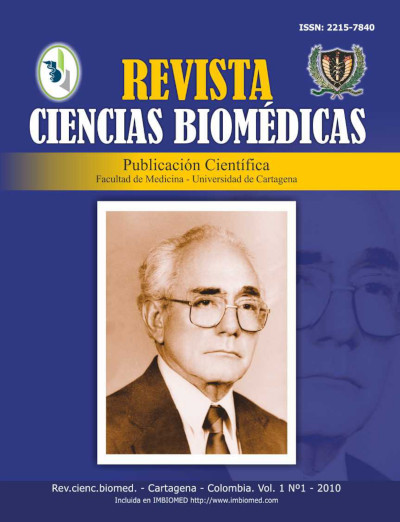Estesioneuroblastoma
Estesioneuroblastoma
Contenido principal del artículo
Resumen
El estesioneuroblastoma es un tumor embrionario, originado en la mucosa olfatoria. Representa del 2 al 4 % de los tumores malignos de las áreas nasosinusales. Puede aparecer a cualquier edad, este tumor tiene baja malignidad y se tiene una supervivencia a los 10 años de 60 a 75%. Se presentan tres casos manejados en el Instituto Nacional de Cancerología en Bogotá, Colombia. Rev.cienc.biomed. 2010, 1(1): 96-101.
Palabras clave
Descargas
Datos de publicación
Perfil evaluadores/as N/D
Declaraciones de autoría
- Sociedad académica
- Universidad de Cartagena
- Editorial
- Universidad de Cartagena
Detalles del artículo
Referencias (VER)
Arnold PM, Habib A, Newell K, Anderson KK. Esthesioneuroblastoma metastatic to the thoracic intradural and extradural space. Spine J 2009; 9(5): 1-5.
Bastin KT, Steeves RS, Gilchrist KW. Esthesioneuroblastoma: diagnosis, prognosis, and treatment. Wis Med J 1993; 92(1): 17-9.
Berger L, Luc G, Richard D. The olfactory esthesioneuroepithelioma. Bull Assoc Franc Etude Cancer 1924; 13: 410–421.
Bragg TM, Scianna J, Kassam A, Emami B, Brown HG, Hacein-Bey L, et al. Clinicopathological review: esthesioneuroblastoma. Neurosurgery 2009; 64(4): 764-770.
Chen YF, Yang AK, Zhang Q, Ouyang D, Chen WK, Chen FJ. Clinical analysis of 53 cases of esthesioneuroblastoma. Chin J Cancer 2009; 28(3): 259-262.
Dias FL, Geraldo M. Patterns of failure and outcome in esthesioneuroblastoma. Arch. Otolaryngol Head Neck Surg 2003; 129: 1186-1192.
Dulguerov P, Allal AS, Calcaterra TC. Esthesioneuroblastoma: a meta-analysis and review. Lancet Oncol 2001; 2(11): 683-690.
Dulguerov P, Calcaterra TC. Esthesioneuroblastoma: the UCLA esxperience 1970-1990. Laryngoscope 1992; 102: 843-849.
Eich HT, Staar S, Micke O. Radiotherapy of esthesioneuroblastoma. Int J Radiat Oncol Biol Phys 2001; 49:155-160.
Gil-Carcedo E, Gil-Carcedo LM, Vallejo LA, deCampos JM. Tratamiento del estesioneuroblastoma. Revisión de la literatura. Acta Otorrinolaringol Esp 2005; 56:389-395.
Kadish S, Goodman M, Wang CC. Olfactory neuroblastoma. A clinical analysis of 17 cases. Cancer 1976; 37(3):1571-1576.
Koka VN, Julieron M, Bourhis J, Janot F, Le Ridant AM, Marandas P, et al. Aesthesioneuroblastoma. J Laryngol Otol 1998;112(7):628-633.
Li JS, Xie FY, Peng M, Han F. [Clinical analysis of 20 adults esthesioneuroblastoma with combined therapy]. Zhonghua Er Bi Yan Hou Tou Jing Wai Ke Za Zhi 2009; 44(1):36-39.
Link M, Ebersold M, Olsen K, Foote R, Buckner J, Quast J. Esthesioneuroblastoma- Mnagement and Outcome. In: Kaye A, Laws E, editors. Brain Tumors. London: Churchill Livingstone; 2001. p. 899-914.
Martinez J, Dominguez LJ, Urpegui A. Olfactory esthesioneuroblastoma. Review of seven cases. Acta Otorrinolaringológica Española 1998;49(4):293-296.
Mattavelli F, Pizzi N, Pennacchioli E, Radaelli S, Calarco G, Quattrone P, et al. Esthesioneuroblastoma metastatic to the trachea. Acta Otorhinolaryngol Ital 2009;29(3):164-168.
McCormack LJ, Harris HE. Neurogenic tumors of the nasal fossa. JAMA 1955;157:318–321.
Morita A, Ebersold MJ, Olsen KD, Foote RL, Lewis JE, Quast LM. Esthesioneuroblastoma: prognosis and management. Neurosurgery 1993;32(5):706-14; discussion 714-5.
Nieto-Hernandez L, Rodríguez-Verdugo M, Nieto-Fernández J, Cordoncillo-Prieto J. Estesioneuroblastoma. A propósito de 3 casos. ORL-DIPS 2003;30(2):106-109.
Sakata K, Aoki Y, Karasawa K, Nakagawa K, Hasezawa K, Muta N, et al. Esthesioneuroblastoma. A report of seven cases. Acta Oncol 1993;32(4):399-402.
Takahashi H. Olfactory neuroblastoma (aesthesioneuroblastoma) and olfactory neuroepithelioma. No To Shinkei 1994;46(12):1134-41.



 PDF
PDF
 FLIP
FLIP





